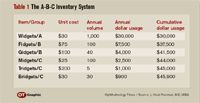Article
Inventory measurement should be focused, prioritized
A crucial asset of almost any business entity is its inventory. Appropriate inventory control has always been important. However, given the challenging business climate that health-care entities presently face, excellent inventory management systems are now essential to business survival.

What exactly is inventory? In general terms, inventory can be considered a "stock of goods." The exact nature of inventory, though, will vary with the type of business under consideration.

Part of current assets Inventory is carried on a business' balance sheet as a component of current assets. Current assets are those assets that can be converted into cash within a current accounting period. The typical accounting period is taken as 1 year.
One reason that accurate inventory measurement is paramount is that several carefully watched financial ratios depend on the level of measured inventory.
An example financial ratio is return on investment. The numerator in the return on investment ratio is operating income. The denominator is often taken as total assets. Inventory is an important part of total assets. If inventory is high, total assets look high and therefore return on investment appears low. Stock prices and company value often fall when return on investment is considered low. This effect can be devastating for a company.

One purpose of inventory is to meet demand from customers. Inventory kept to meet the planned or expected demand from customers is known as anticipation stock. Inventory kept to protect against demand in excess of current supply is known as safety stock.
Another reason to accumulate inventory is to minimize purchasing cost. An ambulatory surgery center may receive a volume discount for purchasing in volumes in excess of demand. Inventory known as speculative stock may be acquired because a price hike is expected.
Inventory is also acquired to minimize operating cost. Cycle stock is sometimes accumulated in this fashion because an automatic order system has been implemented. Such a system is often inexpensive, because minimal or no monitoring is required. This is not a panacea, however, because cycle systems present the possibility that materials are ordered far in excess of the anticipated need.
A-B-C inventory system One of the best known means of classifying inventory is known as the A-B-C inventory system. This well-known technique identifies the approximately 20% of types of items held in inventory that constitute 60% to 70% of the "importance" of the inventory stocks. Importance is usually defined as annual dollar usage.
Newsletter
Don’t miss out—get Ophthalmology Times updates on the latest clinical advancements and expert interviews, straight to your inbox.




